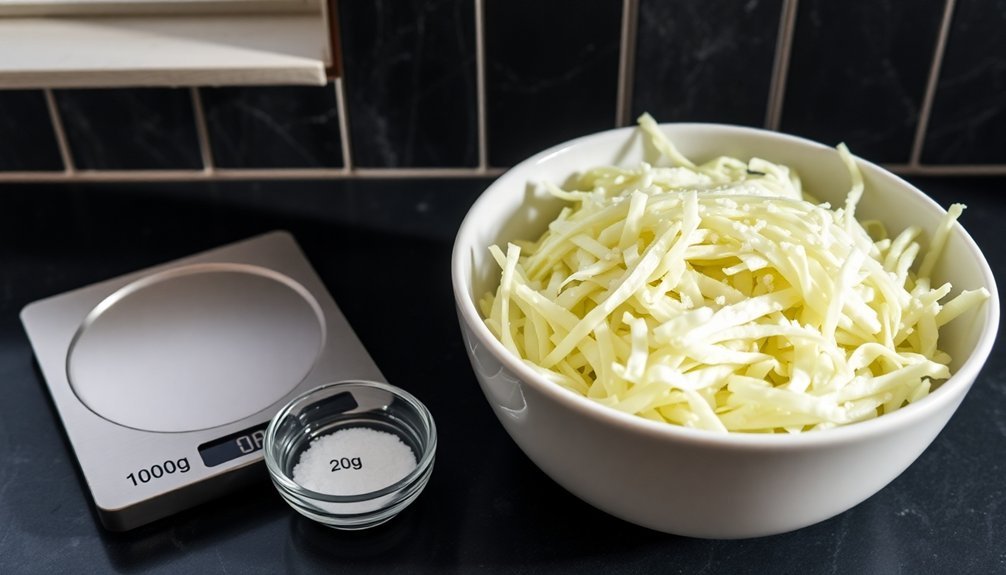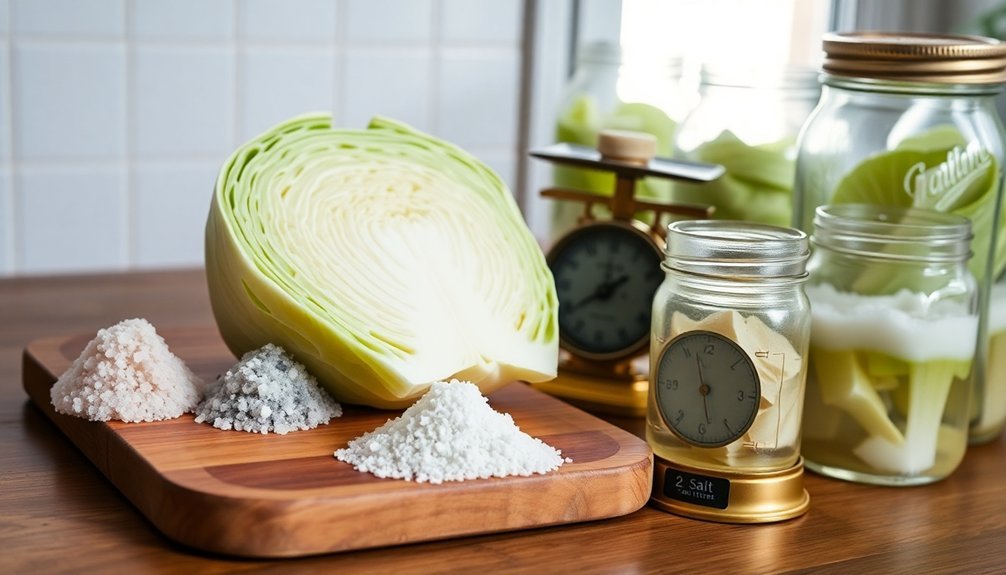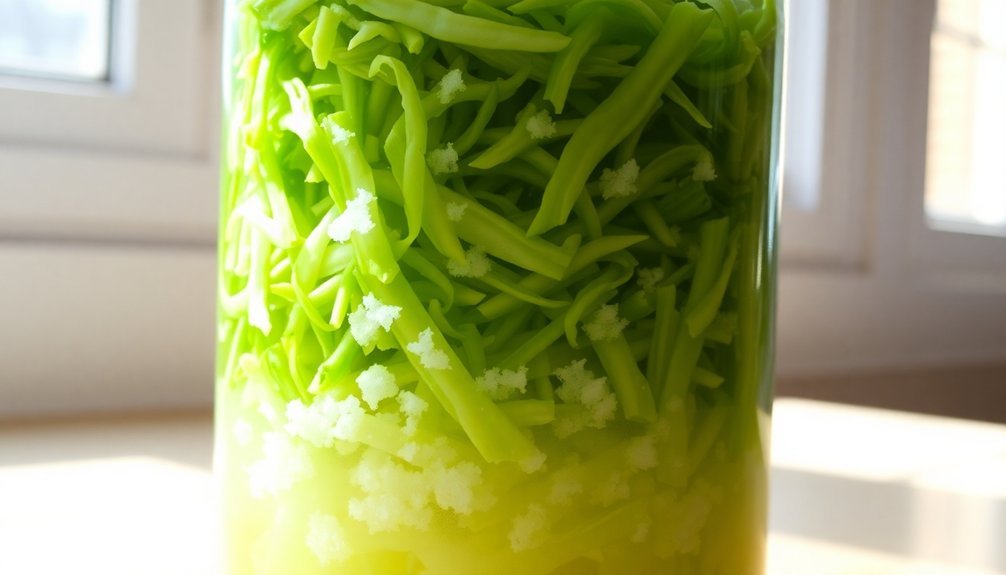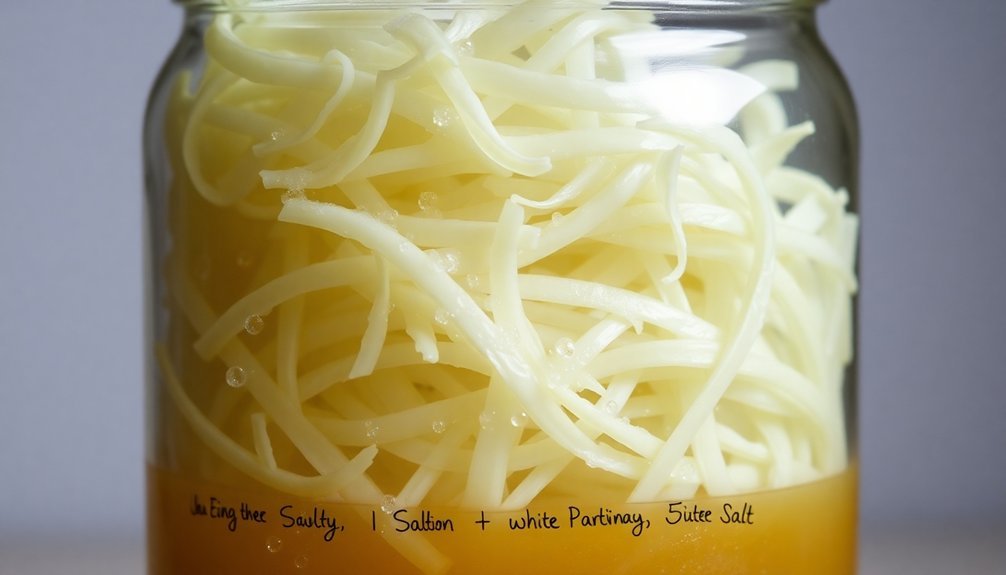For perfect sauerkraut, you'll want to maintain a salt-to-cabbage ratio between 1.5% to 2.5% by weight, with 2% being ideal. Use a digital kitchen scale for precise measurements, as volume measurements can be unreliable. You'll need pure, unrefined salt without additives – Himalayan pink salt or Real Salt® work great. Keep your fermentation temperature between 60°F to 70°F (16°C-21°C), with 65°F (18°C) being optimal. Avoid iodized table salt, which can inhibit beneficial bacteria growth and lead to off-flavors. Understanding these key ratios and conditions will transform your cabbage into perfectly crisp, tangy sauerkraut.
Understanding Salt Ratios

Throughout the fermentation process, achieving the correct salt-to-cabbage ratio stands as the cornerstone of successful sauerkraut making. You'll find that salt concentration plays a critical role in both the quality and safety of your fermented cabbage, creating an ideal environment for beneficial bacteria while inhibiting unwanted microorganisms.
The ideal salt ratio typically falls between 1.5% and 2.5% of your cabbage's weight, with 2% being the most widely accepted standard. This means if you're working with 100 grams of cabbage, you'll need 2 to 2.25 grams of salt. You can adjust this ratio based on your fermentation environment and personal taste preferences. For large batches, use 2-3 tablespoons of salt for every 5 pounds of cabbage.
When you're measuring your salt, remember that different types of salt can affect the overall salinity. Your local climate and temperature will also influence how much salt you'll need – cooler weather generally requires less salt (around 1.5%), while warmer conditions may need up to 2.5%.
If you don't get the ratio right, you'll risk either spoilage from too little salt or halted fermentation from too much. The key is precision in your measurements to guarantee consistent, successful results.
Measuring Salt and Cabbage
Using a digital kitchen scale will give you the most accurate measurements for creating perfectly salted sauerkraut.
Different salt types, from fine sea salt to coarse kosher salt, can vary markedly in weight per volume, making weight-based measurements essential for consistency.
You'll need basic tools like a digital scale, mixing bowl, and sanitized containers to measure and prepare your ingredients properly. For optimal fermentation results, aim for a 1.5% to 2.5% salt-to-cabbage ratio by weight.
Digital Scale Best Method
While many home fermenters rely on measuring spoons or taste testing, a digital kitchen scale stands out as the most reliable method for achieving perfect salt-to-cabbage ratios in sauerkraut. You'll get consistent results by weighing your trimmed cabbage in grams and multiplying that weight by your desired salinity percentage (typically 1.5% to 2.5%). This precise measurement guarantees safe fermentation and ideal flavor development. Too much variation in salt content can result in slow bacterial growth.
Using a digital scale eliminates the guesswork and variability that comes with volume measurements. You can easily adjust batch sizes while maintaining the correct ratios, and you'll be able to replicate your successful ferments with confidence.
For best results, use clean, sterilized equipment and maintain proper fermentation temperatures between 18°C to 21°C (64°F to 70°F).
- Calculate salt weight by multiplying cabbage weight by 0.02 for a 2% brine
- Store fermented cabbage beneath its brine to maintain proper fermentation
- Consider using unrefined salts like Himalayan or Real Salt for added minerals
- Keep detailed records of weights and measurements to replicate successful batches
Salt Types Impact Weight
Three common salt varieties – fine table salt, kosher salt, and mineral-rich salts – can greatly impact your sauerkraut measurements due to their different densities and grain sizes.
When you measure by volume, you'll get varying amounts of actual salt depending on the type you're using. For instance, three tablespoons of fine table salt will give you more salt by weight than the same volume of coarse kosher salt.
The differences are significant: three tablespoons of Pink Himalayan Salt weighs 54g, while Great Value Coarse Salt comes in at 60g. Regular table salt weighs 51g, and Windsor Coarse Kosher Salt only 48g for the same volume.
These variations can seriously affect your salt-to-cabbage ratio and, consequently, your fermentation results.
If you're using mineral-rich salts like Himalayan Pink or Redmond Real Salt, remember they contain slightly less sodium chloride than regular table salt.
While their trace minerals can benefit fermentation, you'll still want to maintain the recommended 1.5-2.5% salt concentration by weight. This is why measuring by weight, rather than volume, becomes essential for consistent, successful fermentation.
Essential Kitchen Tools Required
For precise sauerkraut fermentation, you'll need several essential measuring tools to achieve the perfect salt-to-cabbage ratio. A digital kitchen scale stands as your most vital tool, allowing you to weigh both cabbage and salt with accuracy.
When using the scale, you'll want to set it to grams for the most precise measurements and utilize the tare function to zero out the weight of your mixing bowl.
While measuring spoons might seem convenient, they're less reliable for salt measurement due to varying densities between different salt types. Instead, rely on your digital scale and a dedicated bowl or container for consistent results.
You'll also need a large mixing bowl for combining the ingredients and a colander if you need to drain excess liquid during the process.
- Use a scale that measures in 1-gram increments for best precision
- Always zero out (tare) your scale with the container before adding ingredients
- Keep your measuring tools clean and dry to prevent cross-contamination
- Store your digital scale in a moisture-free environment to maintain accuracy
Remember to maintain a clean workspace and sanitized measuring tools throughout the process to guarantee proper fermentation.
Salt Types for Fermentation

When making sauerkraut, you'll want to select a high-quality, additive-free salt like Himalayan Pink Salt or Real Salt® to guarantee ideal fermentation.
These unrefined salts contain beneficial minerals that enhance your sauerkraut's nutritional value while supporting the growth of good bacteria.
While refined salts without additives can work in a pinch, they won't provide the same mineral benefits as unrefined options, so it's worth investing in proper fermentation salt for the best results.
Best Fermentation Salt Choices
Selecting the right fermentation salt can make or break your sauerkraut's success. You'll want to choose salts that are free from additives and rich in minerals to guarantee proper fermentation. Himalayan Pink Salt and Real Salt® stand out as top choices, offering over 84 trace minerals and completely natural compositions without anti-caking agents or artificial additives.
If you're new to fermentation, Kosher salt's coarse texture makes it easy to work with, but you'll need to check the label for unwanted additives. Unrefined sea salt can work well too, but be selective – opt for varieties that list only sodium chloride as an ingredient to avoid potential contaminants.
- Choose mineral-rich options like Himalayan Pink Salt or Real Salt® for peak fermentation and nutrient content
- Avoid iodized table salt, which can inhibit beneficial bacteria growth
- Look for salts without anti-caking agents, aluminum compounds, or other additives
- Store your fermentation salt in a dry place to prevent moisture absorption and clumping
Whether you're using flaked sea salt or coarse Himalayan crystals, your salt choice will directly impact both the fermentation process and final flavor of your sauerkraut.
Salt Purity Matters Most
The purity of your fermentation salt surpasses all other considerations when crafting sauerkraut. Common additives in refined salts, like calcium silicate and potassium iodide, can disrupt your fermentation by inhibiting the beneficial bacteria vital for the process. You'll want to avoid these additives to guarantee consistent, safe fermentation results.
Pure, unrefined salts create the ideal environment for lactic-acid bacteria while enhancing your sauerkraut's flavor and texture. You'll find that mineral-rich salts help reduce perceived saltiness and contribute to a more balanced taste profile. When you use pure salt, you're also assuring even distribution throughout your cabbage, leading to predictable fermentation outcomes within the essential 1.5% to 2.5% salinity range.
| Salt Type | Effect on Fermentation | Impact on Final Product |
|---|---|---|
| Pure Unrefined | Promotes beneficial bacteria | Enhanced flavor, ideal texture |
| Mineral-Rich | Creates balanced environment | Balanced saltiness, good minerality |
| Additive-Free | Guarantees consistent process | Predictable results |
| Iodized (Avoid) | Inhibits fermentation | Poor texture, off-flavors |
| Table Salt (Avoid) | Disrupts bacterial growth | Inconsistent results |
Common Salting Mistakes
Making sauerkraut requires precise salting, yet many home fermenters stumble over common mistakes that can ruin their batch. When you use too little salt (below 1.5%), you'll invite harmful bacteria that create mushy, moldy kraut. Conversely, excessive salt (above 2.25%) slows fermentation and inhibits beneficial bacteria, leaving you with an overly salty product that won't improve with time.
Your measuring method matters considerably. Don't rely on measuring spoons or eyeballing salt quantities, as different salt types have varying crystal sizes and weights. Instead, use a digital scale for consistent results.
You'll also need to guarantee even salt distribution throughout your cabbage – improper mixing creates pockets where harmful bacteria can thrive, leading to slimy or soft spots in your kraut.
- Use a digital scale to measure salt by weight, not volume
- Maintain salt concentration between 1.5% and 2.25% of cabbage weight
- Mix thoroughly to distribute salt evenly throughout the cabbage
- Pack your fermentation vessel tightly to eliminate air pockets that can lead to uneven fermentation
Optimal Fermentation Conditions

During the fermentation process, maintaining precise temperature control can make or break your sauerkraut's success.
You'll want to keep your fermentation temperature between 60°F and 70°F (16°C-21°C), with 65°F (18°C) being the sweet spot for ideal results.
At these perfect temperatures, you'll support the growth of beneficial bacteria like Lactobacillus and Leuconostoc mesenteroides, which create that perfect tangy flavor and crisp texture you're after.
If you're fermenting at 60°-65°F, expect the process to take 5-6 weeks. At slightly warmer temperatures of 70°-75°F, you'll see results in 3-4 weeks.
Don't let your fermentation temperature climb above 75°F, as this will encourage unwanted bacteria growth, leading to soft, mushy kraut with an unpleasant, funky taste.
Similarly, temperatures below 60°F will greatly slow or halt the fermentation process altogether.
Monitor your fermentation every seven days and try to avoid temperature fluctuations exceeding 5°F (3°C).
If you're dealing with an inconsistent fermentation space, you'll need to adjust your fermentation timeline accordingly to achieve the best results.
Safe Salt Percentages
When crafting perfect sauerkraut, you'll need to maintain a salt concentration between 1.5% and 2.5% of your cabbage weight, with 2% serving as the ideal starting point. This precise measurement guarantees you'll create the perfect environment for beneficial bacteria while preventing harmful organisms from taking hold.
Getting your salt ratio right is essential. Too little salt (below 1.5%) can lead to mold growth and soft, mushy kraut, while too much salt (above 2.5%) can slow or stop fermentation entirely. You'll get the best results by weighing your ingredients with a digital scale rather than relying on volume measurements.
- For every 1000g (1kg) of cabbage, use 20g of salt for the ideal 2% ratio
- Choose mineral-rich salts like Himalayan Pink or Redmond Real Salt for better bacterial growth
- Avoid iodized table salt, which can interfere with fermentation
- Adjust your salt percentage based on your environment – use slightly more in warmer conditions
Remember that proper salt concentration isn't just about flavor – it's the key mechanism that controls fermentation speed and maintains food safety throughout the process.
Troubleshooting Salt-Related Issues

Even with careful measuring, salt-related problems can arise in your sauerkraut-making process. If you've over-salted your batch, you can try rinsing off excess salt, though this may reduce flavor and nutrients. Alternatively, adding fresh vegetables can help dilute the salt concentration, or you can incorporate the over-salted batch into a new ferment.
| Issue | Cause | Solution |
|---|---|---|
| Pink Kraut | Salt > 2.25% | Reduce salt ratio to 1.5-2.25% |
| Uneven Fermentation | Poor salt distribution | Mix thoroughly before fermentation |
| Yeast Growth | Excessive salt | Maintain proper salt percentage |
To prevent salt-related issues, you'll need to be precise in your measurements. Using volume measurements can be unreliable since different salt types have varying densities. Instead, weigh your salt with a digital scale and maintain a salinity ratio between 1.5% and 2.5%. Remember that salt content won't decrease during fermentation, so getting it right from the start is vital. Keep your fermentation temperature between 64°F and 75°F, and avoid iodized salt, which can cause discoloration. These steps will help guarantee your sauerkraut ferments properly and safely.
Frequently Asked Questions
Can I Reuse the Brine From a Previous Batch for New Sauerkraut?
Yes, you can reuse old sauerkraut brine! Add 1/4 cup of your previous batch's brine per quart of new ferment. It'll jumpstart fermentation with helpful bacteria, but make sure your old brine's clean and mold-free.
How Long Can Properly Salted Sauerkraut Be Stored at Room Temperature?
You can store properly salted sauerkraut at room temperature for about a month, but you'll want to check for signs of spoilage. After that, it'll start degrading and losing probiotic benefits.
Should I Add Salt if Liquid Doesn't Form After Massaging Cabbage?
If you don't see liquid forming after thoroughly massaging your cabbage, you can add more salt, but stay within 1.5-2.5% of cabbage weight. Wait a bit between additions to avoid over-salting.
Can Medications or Health Conditions Affect How Much Salt I Should Use?
Yes, your medications and health conditions can affect safe salt levels. If you're on blood pressure meds, corticosteroids, or have heart, kidney, or blood pressure issues, consult your doctor about salt consumption.
Does Altitude Affect the Recommended Salt-To-Cabbage Ratio for Fermentation?
No, you don't need to adjust your salt-to-cabbage ratio based on altitude. While altitude can affect temperature and humidity, these factors don't change the basic salt requirements for safe and successful fermentation.
In Summary
You'll get the best results with a salt-to-cabbage ratio between 2-3%. If you're just starting out, stick to 2.5% by weight for foolproof fermentation. Remember to weigh your ingredients precisely and use the right salt type – it makes all the difference. Keep these ratios in mind, maintain proper temperatures, and you'll create perfectly crisp, tangy sauerkraut every time. Now you're ready to start fermenting!





Leave a Reply